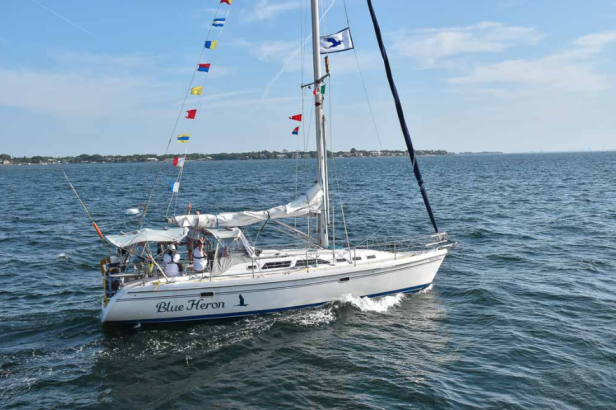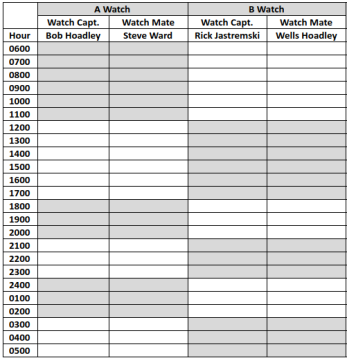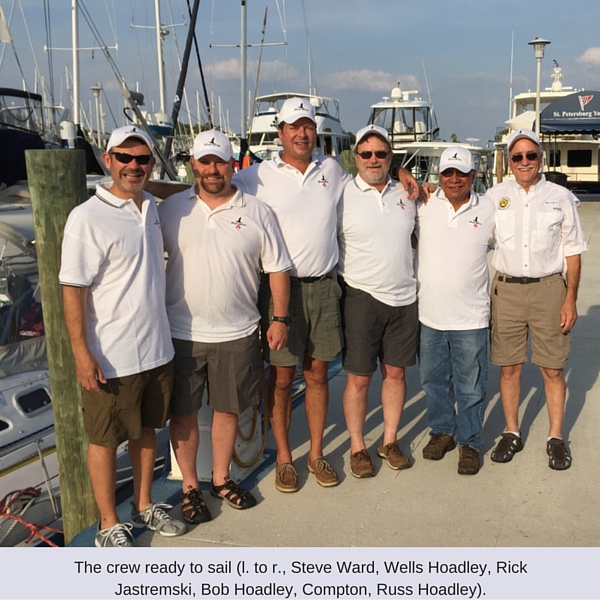A crew of five races 456 nautical miles from Tampa to Mexico on a 38-foot sailboat
Race Day
The dark loops on the weather map are right in our path.
It’s six a.m. and we’re in the van heading to St. Petersburg Yacht Club. I’m reading a new email on my iPhone from our weather router, Mike. Russ dials Mike and puts him on speaker. We work through the forecast and talk over the strategy for our 456 nautical mile race.
How can we avoid a big contrary current and find good wind?
It will be hard. A high pressure system will likely block the steady trade winds, making our ride slow. Add an unusual current and we’re scratching our heads.

We decide on a route that swings far south near Cuba, hoping to avoid the currents.
The Start
After a quick breakfast at the club we board our boat. Everyone is on a job. I’m punching coordinates into the GPS (chartplotter) on deck. Just before nine Russ says, “let’s go” and we shove off and head to the starting area.
We’re racing on Russ’s 38 foot Catalina sailboat. It’s a solid, big boat he bought almost twenty years ago. Blue Heron is very well outfitted: a/c, fridge, generator, even a laptop and printer. It also has the safety gear you need for offshore sailing. Things like an inflatable life raft, EPIRB satellite rescue beacon and a ditch bag with life saving medical kit and food rations.
Near the starting line we warm up, practicing tacks and gybes. Everything on this boat is bigger and heavier than on my lake boat. Grinding the winches is a chore.
We watch other boats in our racing class. Russ’s friend, Tom, is on a 46’ Beneteau. A Hylas 54, Jeanneau 45 and our Catalina 38 round out the class. Everyone is eyeing the big Hylas: there is room enough on her deck for a comfortable stroll around the entire boat. A sixty-two foot catamaran is out here too but it’s a support boat carrying supplies instead of racing.
The radio crackles with announcements, “Three minutes until preparatory flag down with sound.”
The starting line stretches between a race committee powerboat and a yellow floating mark a quarter mile away. The fleet is milling around without purpose yet; tacking, gybing, pointing high, sailing low.
“Squeearrk,” the horn whimpers and we’re off!

We have a great start, second across the line.
We sail into the Bay toward the Sunshine Skyway Bridge connecting St. Petersburg to points south on Tampa Bay. The winds are squirrelly, a mix of fresh breezes and dead calms.
As we near the bridge the breeze freshens noticeably — so much that we have to shorten sail to control the boat. We have to carefully steer between the concrete pylons of the bridge. Too far left and we’ll stall and lose control; too far right and we risk being pushed into a pylon.
Bob Hoadley, Russ’s nephew, steers while we approach the left pylon. After much maneuvering and closely watching the gap we make it through.
In a few hours the rush of the start wears off and we settle in. As the afternoon sun dips we see only two other regatta boats. The rest are far ahead or behind.
Military Time
It’s midnight, my first night shift. I’m trying to wake up in the pitch dark and the bunk is tilting and rolling. I have to find my shoes, hat, glasses, knife, flashlight, headlamp, life jacket and harness. I can’t see a thing and don’t remember where this stuff is. I stumble around, find a headlamp (red beam to prevent night blindness) and get myself ready.
“It’s more military,” Russ says, describing the watch schedule later in the trip.
No kidding.
To keep the boat moving 24 hours a day we use two watches of twelve hours each, with breaks spread throughout. I’m on A shift with Bob; Rick and Wells are on B (see chart nearby).

The first night is tough but it’s just a warm up. The midnight shift gets harder each day. Thankfully Russ is ready with hot chocolate and coffee when we come on duty each night.
That’s how things work for the entire trip: we A and B shift guys on a strict schedule and Russ “floating” in and out when we need help with the sails or advice on a ship we’ve sighted. I don’t know how Russ does it. He gets less uninterrupted sleep than anyone.
Out There
One night I’m in my bunk shortly after 3 a.m. trying to relax. I need sleep but with the rocking and rolling I can’t settle down. It doesn’t help that I’m thinking about sailing stories. Just last week I was telling my wife, “What you really worry about is hitting a big heavy object like a sea container.” Fiberglass sailboats don’t do well against sea containers. Oh great….just what I need to calm my mind for sleep.
On another evening the B shift guys see the lights of several ships. To be on the safe side they hail a couple of them on the VHF radio. It’s too easy to miss our small sailboat in the inky darkness. They hear Russian or Eastern European accents answer the radio.
Log of S/V Blue Heron ( day 4, Mon. Apr 25 0600): Entered shipping lane for Cuba. Had to make contact with two cargo shops to avoid “Dolce Via” & “Battersea.” Had 5-6 motor vessels on both sides at one point. Dropped pole.
∼∼∼
The Conveyor Belt
One afternoon we see 10 knots on the boat’s speedometer. A fantastic speed! Except that we’re not making nearly that progress. With adverse current we’re like salmon swimming upstream. We’re practically sprinting through the water but the GPS shows what really matters: only 5 over the ground.
This is the worst of the loop current we were trying to avoid.
Gradually over the next few days, as we slip alongside and then past Cuba, we eventually get out of the bad currents. Once we sail into the Yucatan Channel, the open water between Cuba and Mexico, we get heavier winds and waves but thankfully more favorable currents.
By the fourth night (our last before making landfall) we are really cookin’. We begin to see speeds in the 8s and 9s. It’s a wild exciting ride now, with six to eight foot waves and winds into the high twenties. We’re rollicking over the waves on our way to Isla, feeling like a freight train.
The Finish
Around 4:30 on our fifth morning I’m still in my bunk (my shift is not until six). But I can hear more than the usual commotion up top. Turns out we are near the finish.
It’s pitch black so we approach the Mexican coastline with care. Dark sailing is fairly simple if you’re hundreds of miles out to sea. It’s the coastline that gets your real attention.

Finally we see lights ashore – something I haven’t seen in five days. We begin to look for the finish boats. Ahead we see lights from the Mexican Navy vessel that is part of our finish line. The ship puts a spotlight on our finish pin.
At 5:20 – BANG! – fireworks shoot into the air, signaling our finish. What a great way to finish a race. We made over 500 miles and it took us just under five days (about 115 hours).
Thanks, Russ, Bob, Wells and Rick, for making this a trip to remember!





Cool!! Krissy and I kept looking at your progress wondering why you were going to Cuba!!! I bet you were exhausted.
Just watched sailing around the world or something like that. A solo race. Showed them hitting crap in the middle of the ocean and they were done for the race
>
LikeLike
Great story, Steve. Thanks for memorializing a super sail!
LikeLike
Thanks, Russ. I had a great time – what an experience. Thanks for having me aboard.
Steve
LikeLike
Great writing Steve! I really enjoyed it…makes me miss sailing! What did y’all eat during the trip? Any other fun experiences, i.e. dolphins catching a free ride on the bow wake?
LikeLike
Thanks, Rich. We ate a bunch of different things. Lunch was usually sandwiches or wraps. Dinners were mostly hot meals like lasagna one night and swedish meatballs another. Russ was such a gracious host – he made all the food!
We did have dolphins cruise by a couple times. I’ll have to find the videos I shot of them and send to you.
You should come down to Austin for some fun and sailing!
LikeLike
Loved your story and enjoyed having you on my Watch. Hopefully we can race again sometime soon. Let me know if you need any help with that sweet new boat. 😉
Oh Yah, HOW DO YOU SPELL “BOB”?
LikeLike
Bob, I thoroughly enjoyed being on watch with you too. Yes, I would like to race again with you. Speaking of the boat, I just changed the oil this weekend. An interesting chore made more challenging because our docks are now only reachable by shuttle boat (the lake is so high the marina can’t keep the docks near land). You, as a fellow experienced Catalina owner, probably could have given some good tips!
Oh, I was just telling some friends your BOB story. Love it!
Cheers
LikeLike